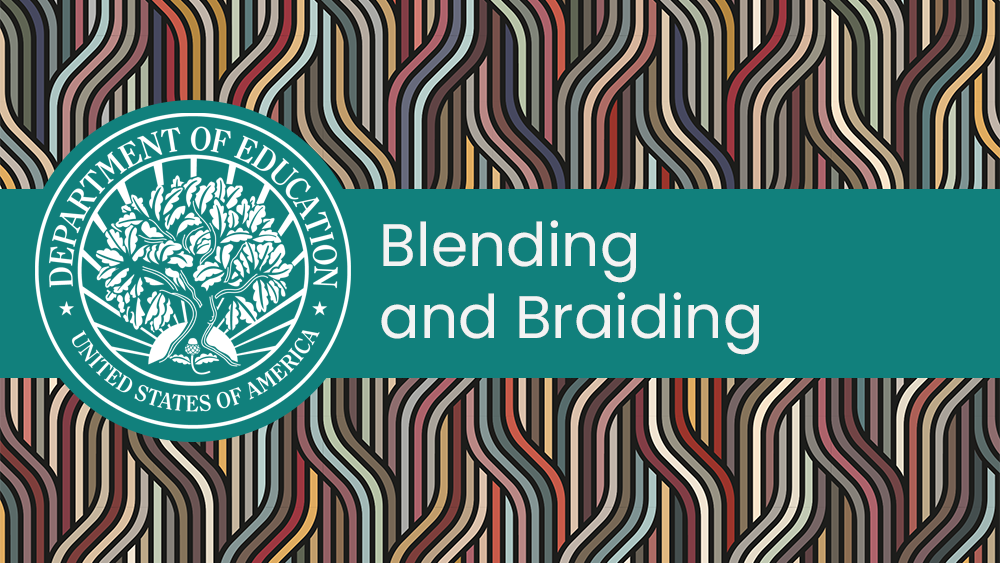Resources
The Promise Neighborhoods Training and Technical Assistance team, the U.S. Department of Education, Promise Neighborhoods grantees, and key technical assistance partners have produced written guidance, tools, and videos about how to launch and manage a successful cradle-to-career pipeline of solutions and strategies for early learners, students, and families in economically distressed communities. Resources appear in the order they were added with the most recent additions first.

Cradle to Career
Find resources related to the four pipeline areas: Early Childhood, Kindergarten to Grade 12, College and Career, and Family and Community Supports

U.S. DEPARTMENT OF EDUCATION AND WHITE HOUSE WEBINAR SERIES
Understand how to blend and braid federal, state, and local funds to implement whole child approaches to education.

Sustaining a Promise Neighborhood
Learn about sustaining Promise Neighborhoods from grantees and others with expert guidance and reflections.
Results (93)
Session 4 - Engaging the Philanthropic Community as a Catalyst for Scaling up Place-Based Whole Child Partnerships
Author: U.S. Department of Education and the White House | Year of Publication: 2024
Philanthropic communities often play a key role in helping place-based programs organize and scale their efforts. This webinar, held on December 5, 2024, features leaders from national philanthropic organizations to discuss how they work with communities to maximize their impact. They will also talk about their role in helping jumpstart and sustain promising cradle-to-career programming. Panelists will share how they think about their role in the context of American Rescue Plan Act funds sunsetting. Specifically, how communities can sustain student and community-centered investments with a blending and braiding approach to funding.
COVID-19 Response and Recovery in Promise Neighborhoods 2020-2022
Author: Jillian Spindle and Lori Nathanson | Year of Publication: 2023
A Promise Neighborhood is a place-based, collective impact approach to improving results for children and families. When the COVID-19 pandemic hit in 2020, Promise Neighborhoods were uniquely positioned to provide on-the-ground community response. They were partners to government, philanthropies, businesses, and community institutions in reaching students, parents, and neighbors with essential emergency services and vital information. This paper explores Promise Neighborhoods’ response to the COVID-19 pandemic and demonstrates that investing in Promise Neighborhoods produces more than academic results; it ensures critical community infrastructure is available during times of crisis.
Community Engagement Family Supports Financial Security Health and Wellbeing K-12 Academic Performance Parent and Community Engagement Policy & Systems Program Delivery/Partners
Expanding Data Use to Support More Effective Post-High School Transitions: Measuring Postsecondary Success in Promise Neighborhoods
Author: Sonia Torres Rodríguez and Elizabeth Burton | Year of Publication: 2022
This brief focuses on Promise Neighborhood grantees that collect and report data on high school graduates who obtain a postsecondary degree, certification, or credential. It also explores strategies to assess the employment outcomes of youth in Promise Neighborhoods. The brief includes guidance and best practices on expanding data use and capacity for Promise Neighborhood grantees and peers to improve their measurement of postsecondary engagement and success.
Collecting, Analyzing, and Using Data Post-Secondary Success Data Collection
Building the Cradle in a Cradle-to-Career Initiative: Three Opportunities for Promise Neighborhoods to Promote Kindergarten Readiness
Author: Megan Gallagher and Shubhangi Kumari | Year of Publication: 2022
Early care and education (ECE) programs are crucial for positive educational and developmental outcomes of children. This brief provides a framework to support Promise Neighborhoods’ ECE work, specifically preparing young children for school in the wake of the COVID-19 pandemic.
Data Collection Community Engagement Early Childhood Education Family Supports
Using Collective Impact to Drive Greater Postsecondary and Career Success
Author: Dan Duncan | Year of Publication: 2021
Promise Neighborhoods is a cradle-to-career initiative dedicated to building supports that can help ensure educational and career success for all neighborhood youth. One of the program’s goals is to make sure high school graduates obtain a postsecondary degree, certificate, or credential. This brief offers five collective impact strategies for Promise Neighborhood grantees to drive greater postsecondary results.
Framing Communications to Drive Social Change
Author: Emily Peiffer, Megan Gallagher | Year of Publication: 2021
Framing is a crucial part of storytelling in all communications—from social media posts to long-form articles to funder presentations. Framing can determine how audiences interpret a message and whether the product achieves its goal. This brief summarizes a course presented by the FrameWorks Institute in partnership with the U.S. Department of Education and the Urban Institute, as part of the Promise Neighborhoods federal training and technical assistance support. The course explores how the right framing can encourage audiences to understand the systemic causes of and solutions to social problems.
Evaluating Programs and Impact within Promise Neighborhoods
Author: Peter A. Tatian, Benny Docter | Year of Publication: 2020
Place-based education and community change interventions such as Promise Neighborhoods face distinct challenges designing and executing high-quality evaluations. Because these efforts attempt to create population-level change by using a comprehensive continuum of cradle-to-career programming, experimental evaluation methods may be impractical or inappropriate. Nevertheless, planning, formative, and quasi-experimental methods can be used to conduct rigorous and instructive evaluations of Promise Neighborhoods.
Collecting, Analyzing, and Using Data Early Childhood Education Family Supports
Introduction to Data Quality: A Guide for Promise Neighborhoods on Collecting Reliable Information to Drive Programming and Measure Results
Author: Peter Tatian with Benny Docter and Macy Rainer | Year of Publication: 2020
This brief provides a basic overview of data quality management principles and practices that Promise Neighborhoods and other community-based initiatives can apply to their work. It also presents examples of data quality practices Promise Neighborhoods have implemented. The target audiences are people who collect and manage data within their Promise Neighborhood (whether directly or through partner organizations) and people who need to use those data to make decisions, such as program staff and leadership.
Taking Promise Neighborhoods to the State Level: Lessons from California and Minnesota
Author: Alyse D. Oneto and Megan Gallagher | Year of Publication: 2020
This brief highlights Promise Neighborhoods grantees that are developing partnerships to extend their impact beyond their neighborhoods to the state level. The brief explores how partnerships in California and Minnesota have established shared goals, invested their time and resources to achieve their goals, and engaged with new stakeholders to build a broader coalition.
Community Engagement Policy & Systems Program Delivery/Partners Staffing, Organization & Leadership
Promoting Sustainability for Promise Neighborhood Grantees: Understanding Needs and Strategies
Author: Sharon Deich, Heather Padgette, and Meghan Neary | Year of Publication: 2020
This brief summarizes findings and recommendations from a needs assessment undertaken to help Promise Neighborhoods grantees and their technical assistance partners understand how the sites are approaching sustainability. The brief also reviews the financial landscape of Promise Neighborhoods grantees.